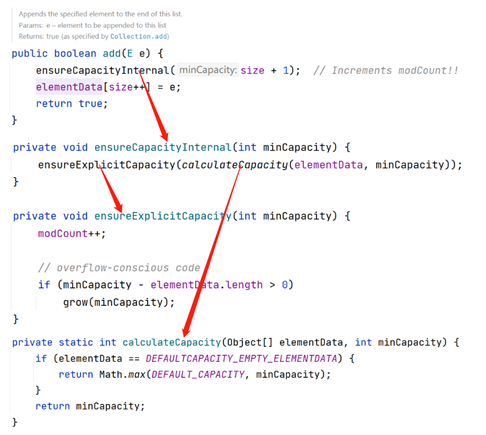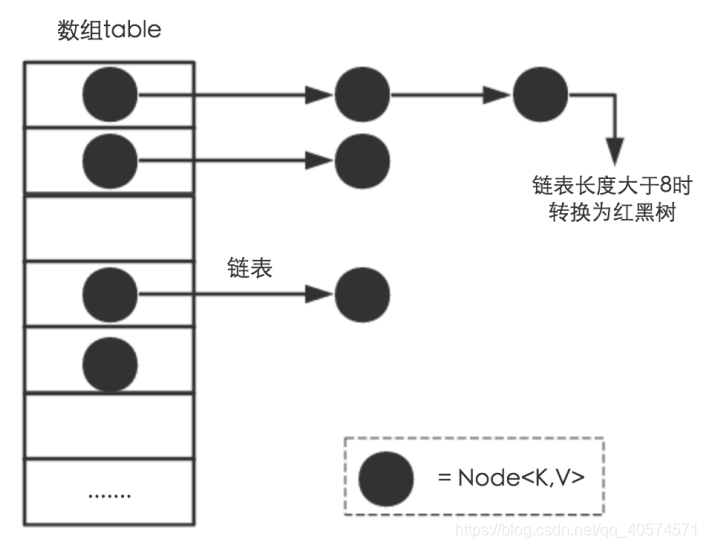概览
容器主要包括Collection和Map两种,Collertion存储着对象的集合,而Map存储着键值对的映射表
Set
List
Queue
源码分析
ArrayList继承自AbstractList,实现了List接口。底层基于数组实现容量大小动态变换,同时还实现了 RandomAccess、Cloneable、Serializable 接口,所以ArrayList 是支持快速访问、复制、序列化的。
public class ArrayList<E> extends AbstractList<E>
implements List<E>, RandomAccess, Cloneable, java.io.Serializable
构造方法
//默认初始容量
private static final int DEFAULT_CAPACITY = 10;
无参构造方法
//构造一个容量大小为10的空list集合,但构造函数只是给elementData赋值了一个空的数组,其实势在第一次添加元素时容量扩大到10的
public ArrayList() {
this.elementData = DEFAULTCAPACITY_EMPTY_ELEMENTDATA;
}
有参构造
构造一个初始容量大小为initialCapacity的ArrayList
//当 initialCapacity 为零时则是把 EMPTY_ELEMENTDATA 赋值给 elementData。 当 initialCapacity 大于零时初始化一个大小为 initialCapacity 的 object 数组并赋值给 elementData。
public ArrayList(int initialCapacity) {
if (initialCapacity > 0) {
this.elementData = new Object[initialCapacity];
} else if (initialCapacity == 0) {
this.elementData = EMPTY_ELEMENTDATA;
} else {
throw new IllegalArgumentException("Illegal Capacity: "+
initialCapacity);
}
}
使用指定 Collection 来构造 ArrayList 的构造函数
//将 Collection 转化为数组并赋值给 elementData,把 elementData 中元素的个数赋值给 size。 如果 size 不为零,则判断 elementData 的 class 类型是否为 Object[],不是的话则做一次转换。 如果 size 为零,则把 EMPTY_ELEMENTDATA 赋值给 elementData,相当于new ArrayList(0)。
public ArrayList(Collection<? extends E> c) {
Object[] a = c.toArray();
if ((size = a.length) != 0) {
if (c.getClass() == ArrayList.class) {
elementData = a;
} else {
elementData = Arrays.copyOf(a, size, Object[].class);
}
} else {
// replace with empty array.
elementData = EMPTY_ELEMENTDATA;
}
}
主要方法
add

每次添加元素到集合中时都会先确认下集合容量大小。然后将 size 自增 1。ensureCapacityInternal 函数中判断如果 elementData = DEFAULTCAPACITY_EMPTY_ELEMENTDATA 就取 DEFAULT_CAPACITY 和 minCapacity 的最大值也就是 10。这就是 EMPTY_ELEMENTDATA 与 DEFAULTCAPACITY_EMPTY_ELEMENTDATA 的区别所在。同时也验证了上面的说法:使用无惨构造函数时是在第一次添加元素时初始化容量为 10 的。ensureExplicitCapacity 中对 modCount 自增 1,记录操作次数,然后如果 minCapacity 大于 elementData 的长度,则对集合进行扩容。
grow
//默认将扩容至原来容量的 1.5 倍。但是扩容之后也不一定适用,有可能太小,有可能太大。所以才会有下面两个 if 判断。如果1.5倍太小的话,则将我们所需的容量大小赋值给newCapacity,如果1.5倍太大或者我们需要的容量太大,那就直接拿 newCapacity = (minCapacity > MAX_ARRAY_SIZE) ? Integer.MAX_VALUE : MAX_ARRAY_SIZE 来扩容。然后将原数组中的数据复制到大小为 newCapacity 的新数组中,并将新数组赋值给 elementData。
private void grow(int minCapacity) {
// overflow-conscious code
int oldCapacity = elementData.length;
int newCapacity = oldCapacity + (oldCapacity >> 1);
if (newCapacity - minCapacity < 0)
newCapacity = minCapacity;
if (newCapacity - MAX_ARRAY_SIZE > 0)
newCapacity = hugeCapacity(minCapacity);
// minCapacity is usually close to size, so this is a win:
elementData = Arrays.copyOf(elementData, newCapacity);
}
private static int hugeCapacity(int minCapacity) {
if (minCapacity < 0) // overflow
throw new OutOfMemoryError();
return (minCapacity > MAX_ARRAY_SIZE) ?
Integer.MAX_VALUE :
MAX_ARRAY_SIZE;
}
remove
//当我们调用 remove(int index) 时,首先会检查 index 是否合法,然后再判断要删除的元素是否位于数组的最后一个位置。如果 index 不是最后一个,就再次调用 System.arraycopy() 方法拷贝数组。说白了就是将从 index + 1 开始向后所有的元素都向前挪一个位置。然后将数组的最后一个位置空,size - 1。如果 index 是最后一个元素那么就直接将数组的最后一个位置空,size - 1即可。 当我们调用 remove(Object o) 时,会把 o 分为是否为空来分别处理。然后对数组做遍历,找到第一个与 o 对应的下标 index,然后调用 fastRemove 方法,删除下标为 index 的元素。其实仔细观察 fastRemove(int index) 方法和 remove(int index) 方法基本全部相同。
public E remove(int index) {
rangeCheck(index);
modCount++;
E oldValue = elementData(index);
int numMoved = size - index - 1;
if (numMoved > 0)
System.arraycopy(elementData, index+1, elementData, index,
numMoved);
elementData[--size] = null; // clear to let GC do its work
return oldValue;
}
public boolean remove(Object o) {
if (o == null) {
for (int index = 0; index < size; index++)
if (elementData[index] == null) {
fastRemove(index);
return true;
}
} else {
for (int index = 0; index < size; index++)
if (o.equals(elementData[index])) {
fastRemove(index);
return true;
}
}
return false;
}
private void fastRemove(int index) {
modCount++;
int numMoved = size - index - 1;
if (numMoved > 0)
System.arraycopy(elementData, index+1, elementData, index,
numMoved);
elementData[--size] = null; // clear to let GC do its work
}
get
//直接调用数组随机访问
public E get(int index) {
rangeCheck(index);
return elementData(index);
}
ArrayList总结:
ArrayList 底层基于数组实现容量大小动态可变。 扩容机制为首先扩容为原始容量的 1.5 倍。如果1.5倍太小的话,则将我们所需的容量大小赋值给 newCapacity,如果1.5倍太大或者我们需要的容量太大,那就直接拿
newCapacity = (minCapacity > MAX_ARRAY_SIZE) ? Integer.MAX_VALUE : MAX_ARRAY_SIZE来扩容。 扩容之后是通过数组的拷贝来确保元素的准确性的,所以尽可能减少扩容操作。 ArrayList 的最大存储能力:Integer.MAX_VALUE。 size 为集合中存储的元素的个数。elementData.length 为数组长度,表示最多可以存储多少个元素。 如果需要边遍历边 remove ,必须使用 iterator。且 remove 之前必须先 next,next 之后只能用一次 remove。
JDK1.8中的改变
在JDK1.6,JDK1.7中,HashMap采用位桶+链表实现,即使用链表处理冲突,同一hash值的链表都存储在一个链表里。但是当位于一个桶中的元素较多,即hash值相等的元素较多时,通过key值依次查找的效率较低。而JDK1.8中,HashMap采用位桶+链表+红黑树实现,当链表长度超过阈值(8)时,将链表转换为红黑树.
结构

存储结构(HashMap 的数据存储结构是一个 Node<K,V> 数组,在(Java 7 中是 Entry<K,V> 数组,但结构相同))
transient Node<K,V>[] table;
构造方法
四种构造方法
//使用指定的初始容量和装载因子构造一个空HashMap,初始容量为目标容量的2次幂
public HashMap(int initialCapacity, float loadFactor) {
if (initialCapacity < 0)
throw new IllegalArgumentException("Illegal initial capacity: " +
initialCapacity);
if (initialCapacity > MAXIMUM_CAPACITY)
initialCapacity = MAXIMUM_CAPACITY;
if (loadFactor <= 0 || Float.isNaN(loadFactor))
throw new IllegalArgumentException("Illegal load factor: " +
loadFactor);
this.loadFactor = loadFactor;
this.threshold = tableSizeFor(initialCapacity);
}
//指定初始容量
public HashMap(int initialCapacity) {
this(initialCapacity, DEFAULT_LOAD_FACTOR);
}
//无参构造,使用默认的初始容量(16)和默认的装载因子(0.75)构造一个空HashMap
public HashMap() {
this.loadFactor = DEFAULT_LOAD_FACTOR; // all other fields defaulted
}
//使用与指定Map相同的映射来构造一个新的HashMap,创建该HashMap时,使用默认的装载因子(0.75)和容纳指定Map的映射的初始容量
public HashMap(Map<? extends K, ? extends V> m) {
this.loadFactor = DEFAULT_LOAD_FACTOR;
putMapEntries(m, false);
}
主要成员变量
主要方法
put
public V put(K key, V value) {
return putVal(hash(key), key, value, false, true);
}
static final int hash(Object key) {
int h;
//根据key来计算哈希值,返回hashCode和无符号右移16位的hashCode值做异或运算
return (key == null) ? 0 : (h = key.hashCode()) ^ (h >>> 16);
}
final V putVal(int hash, K key, V value, boolean onlyIfAbsent,
boolean evict) {
Node<K,V>[] tab; Node<K,V> p; int n, i;
//首次初始化的时候table为null
if ((tab = table) == null || (n = tab.length) == 0)
//对HashMap进行扩容
n = (tab = resize()).length;
if ((p = tab[i = (n - 1) & hash]) == null)//根据hash值来确认存放位置,如果当前位置是空直接添加到table中
tab[i] = newNode(hash, key, value, null);
//有冲突,开始处理
else {
Node<K,V> e; K k;
if (p.hash == hash &&
((k = p.key) == key || (key != null && key.equals(k))))
e = p;//确认当前table中存放键值对的key是否跟要传入的键值对key一致
else if (p instanceof TreeNode)//确认是否为红黑树
e = ((TreeNode<K,V>)p).putTreeVal(this, tab, hash, key, value);
else {//如果hashCode一样的两个不同key,以链表的形式保存
for (int binCount = 0; ; ++binCount) {
if ((e = p.next) == null) {
//为空添加
p.next = newNode(hash, key, value, null);
if (binCount >= TREEIFY_THRESHOLD - 1) // -1 for 1st 判断链表长度是否大于8
treeifyBin(tab, hash);
break;
}
//有相同的key结束循环
if (e.hash == hash &&
((k = e.key) == key || (key != null && key.equals(k))))
break;
p = e;
}
}
if (e != null) { // existing mapping for key
V oldValue = e.value;
if (!onlyIfAbsent || oldValue == null)
e.value = value;//替换新的value并返回旧的value
afterNodeAccess(e);
return oldValue;
}
}
++modCount;
if (++size > threshold)
resize();//如果当前HashMap的容量超过threshold则进行扩容
afterNodeInsertion(evict);
return null;
}
resize
final Node<K,V>[] resize() {
Node<K,V>[] oldTab = table;//首次初始化时table为Null
int oldCap = (oldTab == null) ? 0 : oldTab.length;
int oldThr = threshold; //默认构造器的情况下为0
int newCap, newThr = 0;
if (oldCap > 0) { //如果旧表的长度不为空,即table已经扩容过
if (oldCap >= MAXIMUM_CAPACITY) {
threshold = Integer.MAX_VALUE;
return oldTab;//当table容量大于最大值的时候返回当前的table
}
//容量扩大两倍
else if ((newCap = oldCap << 1) < MAXIMUM_CAPACITY &&
oldCap >= DEFAULT_INITIAL_CAPACITY)
newThr = oldThr << 1; // double threshold 阈值扩大两倍
}
//使用带有初始容量的构造器时,table容量为初始化得到的容量
else if (oldThr > 0) // initial capacity was placed in threshold
newCap = oldThr;
//默认构造器就行扩容
else { // zero initial threshold signifies using defaults
newCap = DEFAULT_INITIAL_CAPACITY;
newThr = (int)(DEFAULT_LOAD_FACTOR * DEFAULT_INITIAL_CAPACITY);
}
//使用带有初始容量的构造器在此处进行扩容
if (newThr == 0) {
float ft = (float)newCap * loadFactor;
newThr = (newCap < MAXIMUM_CAPACITY && ft < (float)MAXIMUM_CAPACITY ?
(int)ft : Integer.MAX_VALUE);
}
threshold = newThr;
@SuppressWarnings({"rawtypes","unchecked"})
Node<K,V>[] newTab = (Node<K,V>[])new Node[newCap];
table = newTab;
if (oldTab != null) {
for (int j = 0; j < oldCap; ++j) {
Node<K,V> e;
if ((e = oldTab[j]) != null) {
oldTab[j] = null;
if (e.next == null)
//当前index没有发生hash冲突,直接对2取模,即移位运算hash & (2^n -1)
//扩容都是2的幂次方进行扩容
newTab[e.hash & (newCap - 1)] = e;
else if (e instanceof TreeNode)
((TreeNode<K,V>)e).split(this, newTab, j, oldCap);
else { // preserve order
//把当前index对应的链表分为两个链表,减少扩容的迁移量
Node<K,V> loHead = null, loTail = null;
Node<K,V> hiHead = null, hiTail = null;
Node<K,V> next;
do {
next = e.next;
if ((e.hash & oldCap) == 0) {
//扩容后不需要移动的链表
if (loTail == null)
loHead = e;
else
loTail.next = e;
loTail = e;
}
else {
//扩容后需要移动的链表
if (hiTail == null)
hiHead = e;
else
hiTail.next = e;
hiTail = e;
}
} while ((e = next) != null);
if (loTail != null) {
loTail.next = null;
newTab[j] = loHead;
}
if (hiTail != null) {
hiTail.next = null;
newTab[j + oldCap] = hiHead;
}
}
}
}
}
return newTab;
}
get
public V get(Object key) {
Node<K,V> e;
return (e = getNode(hash(key), key)) == null ? null : e.value;
}
final Node<K,V> getNode(int hash, Object key) {
Node<K,V>[] tab; Node<K,V> first, e; int n; K k;
if ((tab = table) != null && (n = tab.length) > 0 &&
(first = tab[(n - 1) & hash]) != null) {
//根据当前传入的hash值以及参数key获取一个节点,即为first,如果匹配,返回对应的value值
if (first.hash == hash && // always check first node
((k = first.key) == key || (key != null && key.equals(k))))
return first;
//如果参数key与first不匹配
if ((e = first.next) != null) {
//判断是否是红黑树
if (first instanceof TreeNode)
return ((TreeNode<K,V>)first).getTreeNode(hash, key);
do {
//如果是链表直接循环拿出数据
if (e.hash == hash &&
((k = e.key) == key || (key != null && key.equals(k))))
return e;
} while ((e = e.next) != null);
}
}
//没有数据返回null
return null;
}
原文:https://www.cnblogs.com/zmy98/p/14900668.html